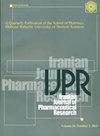Screening and Identification of DNA Nanostructure Aptamer Using the SELEX Method for Detection of Epsilon Toxin
IF 1.8
4区 医学
Q3 PHARMACOLOGY & PHARMACY
引用次数: 0
Abstract
Background: Epsilon toxin (ETX), produced by Clostridium perfringens, is one of the most potent toxins known, with a lethal potency approaching that of botulinum neurotoxins. Epsilon toxin is responsible for enteritis. Therefore, the development of rapid and simple methods to detect ETX is imperative. Aptamers are single-stranded oligonucleotides that can bind tightly to specific target molecules with an affinity comparable to that of monoclonal antibodies (mAbs). DNA aptamers can serve as tools for the molecular identification of organisms, such as pathogen subspecies. Objectives: This study aimed to isolate high-affinity single-stranded DNA (ssDNA) aptamers against ETX. Methods: This study identified aptamers using the Systematic Evolution of Ligands by Exponential Enrichment (SELEX) method, enzyme-linked apta-sorbent assay (ELASA), and surface plasmon resonance (SPR) to determine the affinity and specificity of the newly obtained aptamers targeting ETX. Results: Several aptamers obtained through the SELEX process were studied. Among them, 2 aptamers, ETX clone 3 (ETX3; dissociation constant [Kd] = 8.4 ± 2.4E-9M) and ETX11 (Kd = 6.3 ± 1.3E-9M) had favorable specificity for ETX. The limits of detection were 0.21 and 0.08 μg/mL for ETX3 and ETX11, respectively. Conclusions: The discovered aptamers can be used in various aptamer-based rapid diagnostic tests for the detection of ETX.利用 SELEX 方法筛选和鉴定用于检测 Epsilon 毒素的 DNA 纳米结构适配体
背景:产气荚膜梭菌(Clostridium perfringens)产生的Epsilon毒素(ETX)是已知最“有效”的毒素之一,其致命效力接近肉毒杆菌神经毒素。Epsilon毒素是导致肠炎的原因。因此,开发快速、简便的方法来检测ETX势在必行。适配体是一种单链寡核苷酸,可以与特异性靶分子紧密结合,其亲和力与单克隆抗体(mab)相当。DNA适体可以作为生物分子鉴定的工具,如病原体亚种。目的:本研究旨在分离抗ETX的高亲和力单链DNA (ssDNA)适配体。方法:本研究采用配体系统进化法(SELEX)、酶联apta吸附法(ELASA)和表面等离子体共振法(SPR)鉴定适配体,以确定新获得的适配体靶向ETX的亲和力和特异性。结果:对通过SELEX工艺获得的几个适体进行了研究。其中适配体2个,ETX克隆3号(ETX3;解离常数[Kd] = 8.4±2.4E-9M)和ETX11 (Kd = 6.3±1.3E-9M)对ETX具有良好的特异性。ETX3和ETX11的检出限分别为0.21和0.08 μg/mL。结论:所发现的适配体可用于各种基于适配体的快速诊断检测ETX。
本文章由计算机程序翻译,如有差异,请以英文原文为准。
求助全文
约1分钟内获得全文
求助全文
来源期刊
CiteScore
3.40
自引率
6.20%
发文量
52
审稿时长
2 months
期刊介绍:
The Iranian Journal of Pharmaceutical Research (IJPR) is a peer-reviewed multi-disciplinary pharmaceutical publication, scheduled to appear quarterly and serve as a means for scientific information exchange in the international pharmaceutical forum. Specific scientific topics of interest to the journal include, but are not limited to: pharmaceutics, industrial pharmacy, pharmacognosy, toxicology, medicinal chemistry, novel analytical methods for drug characterization, computational and modeling approaches to drug design, bio-medical experience, clinical investigation, rational drug prescribing, pharmacoeconomics, biotechnology, nanotechnology, biopharmaceutics and physical pharmacy.

 求助内容:
求助内容: 应助结果提醒方式:
应助结果提醒方式:


